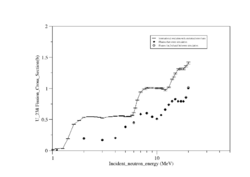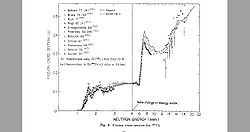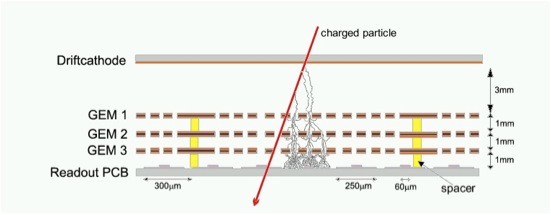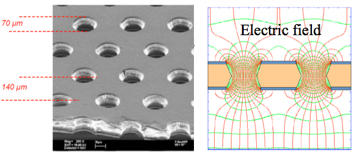H Proposal Defense
Topic
The performance of a neutron sensitive gaseous detector based on thick gaseous electron multiplier preamplifiers.(THGEM)
Introduction
Gaseous detectors using Gas Electron Multipliers <ref name="Sauli1997">F. Sauli, et al, NIM A386, (1997) 531-534 </ref > are becoming common in nuclear and high energy physics experiments. The Gas Electron Multiplier acts as a preamplifier inside the detector allowing the detector's charge collection elements to decrease in size. A kapton based gas electron multiplier (GEM) </ref>requires the technology to etch an array of 50 micron diameter holes in 100 micron thick foils. Thick Gas Electron Multipliers (TGEMs) have 2 mm diameter holes which can be manufactured using a CNC machine. The objective of this work will be to measure the performance of a TGEM that is doped with Uranium to measure fast neutrons that produce fission fragments within the ionization chamber in the presence of the Uranium. This fission chamber like device will have the advantage of measuring the location of the incident neutron on the face of the detector.
Neutrons are nucleons with neutral charge, They interacts generally with high atomic number elements that have high cross sections for certain reactions.Mostly,the neutron interactions are represented by fission, capture,conversion (to an alpha or a proton) and scattering.
A neutron THGEM detector project is basically building the detector using the standards related to THGEM detectors, but adding to the detecting surface an element with a high cross section for a neutron interaction. In our case the THGEM foil will be covered by thorium-232 or uranium-238 which have relatively a high cross section for fission when the neutron energy range is between 5-14 MeV.
The THGEM neutron detector is supported by a read out wire net to get the signal, the read out wire net is connected to a gum stick and a break board, a software (coda) is responsible for collecting and filing the data, then analyzing the data by ROOT (software package).
The quality of the detected signal is dependent on many factors, but the study will be representing the effect of the thickness of the coated radioactive material for U-238 or Th-238 on the detector efficiency. OR comparing the detector properties and mainly the efficiency when it is coated by U-238 layer thickness with case when the coting is Th-232. Also reaching a design for THGEM card maximizes the gain with a the least sparking rate under a voltage applied up to 2 kV.
Chapter 1
Electron Multiplication
The electrons are fermions, negatively charged particles, located around the nucleus. Electron ionization is releasing the electron(s) of the gas from the domain of the nucleus. Any element has an ionization energy, the electron becomes free when it gets an energy higher than its ionization energy.
Lets have positively charged particle like a fission fragment with a certain kinetic energy in an argon gas, electron will starts scattering around the path in all direction for many reasons, but the starting point is bremsstrahlung radiation produced by the decelerating fission fragment,or by colliding directly with the gas atom. the primary electrons produced may also interact with the gas electrons and release more electrons through electron-electron interactions.
In the case of low interacting particles with the gas, the number of the electrons released will not be enough to give an indication of the existence of this particle, so any electron produced primarily should be multiplied.
The free electrons are collected by the surrounding electric field toward a foil with holes, as the electron passes through one of the holes it will be multiplied. <ref name="Sauli1997">F. Sauli, et al, NIM A386, (1997) 531-534 </ref >
pic referece <ref name="CMB_KEK"> CMB Group "Detector technology project connects fields", www.kek.jp/intra-e/feature, Dec.4 2010,http://www.kek.jp/intra-e/feature/2009/KEKDTP.html </ref >
Microscopically, as the electron passes through the hole that has a high concentration of electric field lines, the confinement of the space with strong electric filed will increase the probability of gas ionization to end up with a large number of electrons coming out from the other side of the foil. This process is known by Gas Avalanche multiplication. <ref name="Shalem2005"> Shalem Chen Ken, "R&D of a novel gas electron multiplier – the THGEM", Master Thesis,the Scientific Council of the Weizmann Institute of Science </ref >
Gas Electron Multiplier (GEM)
The first generation of the electron multipliers was the GEM (gas electron multiplier)was made by Sauli <ref name="Sauli1997"/>. Characterized by micrometer scale hole diameter and pitch, relatively low operating voltage , flexibility in taking any shape, high gain at low voltage <ref name="Van Vuure"> T.L vanVuure NIM A477 (2002) 37-40 </ref>. Nevertheless, GEM foil sparking rate increases rapidly,micrometer scale for the design make it hard to maintain. When the design of GEM detector becomes in millimeter scale, the characteristics will change, the new design is called THGEM (thick gaseous electron multiplier).
With the new design for THGEM, the foil becomes rebust, has a higher operating voltage and relatively a higher gain.
Thick Gaseous Electron Multiplier (THGEM)
THGEM detector consists of a gas chamber,THGEM foils,read out wire net, high voltage circuit. A THGEM foil is made from FR4 G10 double sided copper clad, FR4 is 12x12 square plate of thickness is 1 mm and Copper 17 um <ref name="G. Agócs"> G. Agócs,JINST 3 P02012 2008</ref>. Each foil chemically is etched to leave a corner cut square shape frame of length 10cm as represented in the figure. The foil then is painted with a thin layer of a resistive paste (ED-7100) enough to have the current flow on the surface.The foil is machined to have a hole of diameter 0.5 with a rim of 0.15mm from both sides and pitch of 0.8 mm.
Neutron Sensitive THGEM
Sensitivity is a scale for the detector capability to give a usable signal for certain particle(s)[6].Sensitivity is evaluated depends on many factors determined by the detector usage and application. for THGEM neutron detector, the detector sensitivity is mainly depending on neutron energy range, material cross sections for ionization in gas and for neutrons and rates of interactions,detector mass (in tons in the case of neutrinos),background, noise (sparking and electronic devices used to collect the signal) ,materials surrounding the detectors and the strength of the electric field.[6,7]
Assuming a given neutron with fixed energy and flux as well as a fixed material interaction thickness, then the choice of nuclide is the remaining variable to maximize the fission rate of the detector.
Getting the maximum efficiency requires maximizing the rate of interactions by an appropriate choice for neutron and ionization sensitive materials, supported by decreasing the noise and increasing the strength of the electric field in a detector mass built based on THGEM transparency offering a detection area changeable to adapt any application.
Fast neutron X-sect for U-238 and Th-232
The cross section is the proportionality constant for the relationship between the particle traveling distance dx and its probability to make an interaction.
The cross section values are represented as a function of energy. The importance of these curves is giving the value of the cross section for each energy and showing the resonance peaks.Theoretically, there is not any model that gives a detailed prediction of cross section curve, but statistically it is possible to evaluate the parameters for an assumption that describes part of the cross section curve within a certain error.
Neutron fission is one of the interactions commonly takes place spontaneously or under certain experimental conditions. An incident neutron moving with kinetic energy hits a nucleus to produce new nuclei (fragments) and particles.
Neutrons are classified depending on the their kinetic energy into: thermal, intermediate, and fast neutrons. the following table shows the range of each group. Also it shows additional types of neutrons that are important in applications that have neutron energy less than the intermediate range.
| Type | Energy |
| Thermal | 0.025 eV |
| Epithermal | 0.025 eV – 0.2 eV |
| Resonance | 1 eV – 1000 eV |
| Intermediate | 1 keV – 500 keV |
| Fast | > 0.5 MeV |
[Ref.4]
U-238 and Th-232 belong to the actinides. There are characterized with relatively high neutron fission cross section for fast neutrons (specifically for neutron energy higher than 1.5 MeV ).
Change the red and green colors to black.
 |

|
Expected Detector Properties
Ionization Rate
Radiation Backgound
Signal size
Efficiency
Efficiency requires maximizing the rate of interactions by an appropriate choice for neutron fission sensitive material, fission occurs and fission fragments will be created in a gas chamber with a known ionization rate under a certain pressure in a highly dense electric field environment. Amplification occurs for the number of electrons in three stages.The electrons will hit the read out card producing a signal collected by data acquisition system (daq) within a certain electronic noise.
The in our case, the efforts are going to be mostly spent to increase the detector efficiency by studying the radioactive material layer thickness for U-238 or Th-232 to get the highest fission rate.Or comparing the efficiency of the detector when it coated by a layer of U-238 with the one that will be coated with Th-232 layer. In addition to get the best THGEM card design to reach the highest gain with the least sparking rate under a high voltage which may reach up to 2kV.
References
<references/>
1- Media:Shalem_MSthesis_march2005.pdf
2- http://www.kek.jp/intra-e/feature/2009/KEKDTP.html
3- http://wiki.iac.isu.edu/index.php/Data_Acquisition
4- General principles of neutron activation analysis, J. Dostal and C. Elson,p 28 Figure 2.3.
5- Paul Reuss ,Neutron physics,L'editeur EDP Sciences,2008.
6- William R. Leo,Techniques for nuclear and particle physics experiments,1st edition,Springer Verlag, 1995.
7-Ch. Jammes, P. Filliatre, B. Geslot, L. Oriol, F. Berhouet, J-F. Villard, “Research activities in fission chamber modeling in support of the nuclear energy industry”, ANIMMA International Conference, 7-10 June 2009, Marseille, France.

